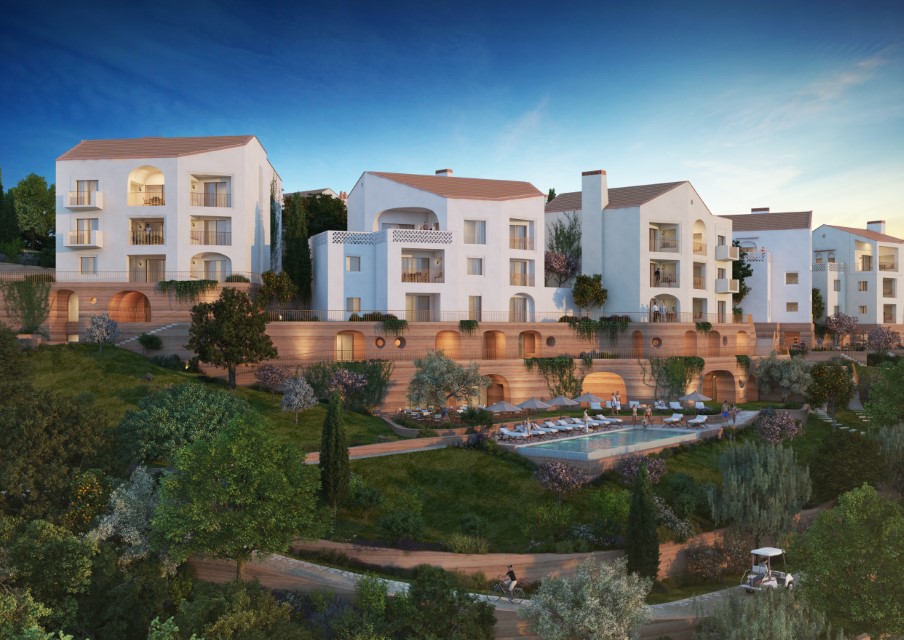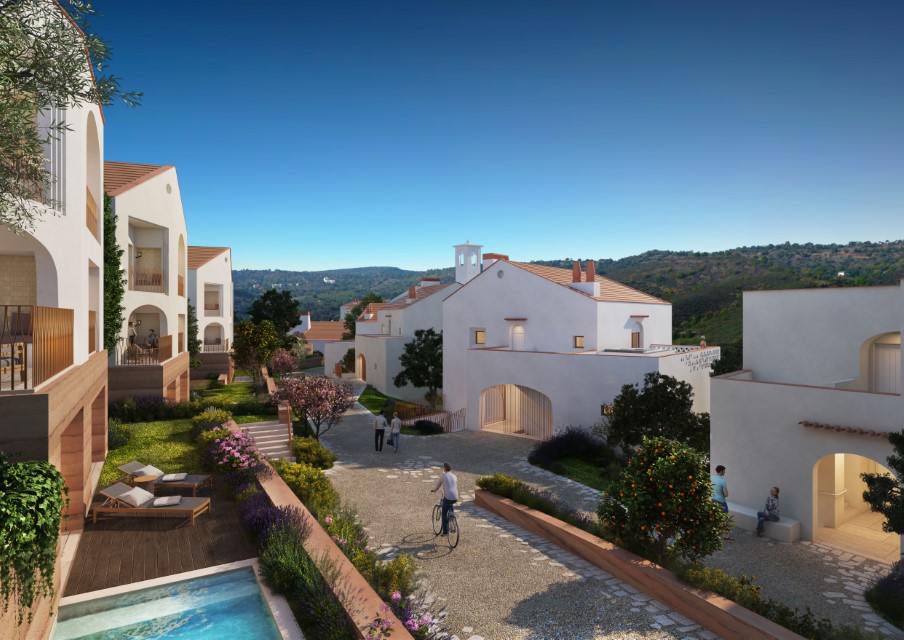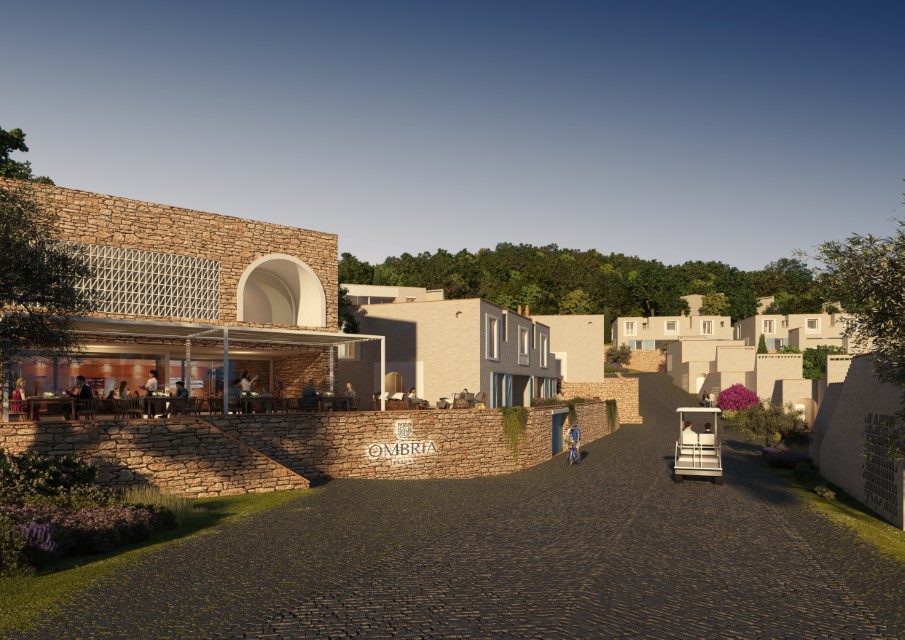 The promoters of Ombria Resort, the real estate development between Tôr and Querença, in the Loulé Council area, have uncapped their eco-pen with a flourish to create the illusion that a villa, apartment, hotel and golf development in the formerly unspoilt Barrocal is a “sustainable” project that “values the region's culture and cultural traditions,” - which in the area in question is, or was, agriculture.
The promoters of Ombria Resort, the real estate development between Tôr and Querença, in the Loulé Council area, have uncapped their eco-pen with a flourish to create the illusion that a villa, apartment, hotel and golf development in the formerly unspoilt Barrocal is a “sustainable” project that “values the region's culture and cultural traditions,” - which in the area in question is, or was, agriculture.
The design of the first phase of the project has been released, an initial investment of €100 million, to include a 5-star hotel with 76 rooms and suites, the Viceroy Residences at Ombria Resort, which include 65 tourist apartments, as well as Alcedo Villas and the Oriole Village, all 'Carved by Nature' accordong to the rather flowery blurb.
The 153-hectare site used to be unspoiled countryside in a highly protected Natura 2000 landscape, under which lies the Algarve’s largest water source, the Querença aquifer.
However, the European Commission decided that this ecologically sensitive site could be 'Carved by Bulldozers' by a Finnish-controlled property company and it finally rejected formal complaints from environmentalists, resting assured that the company would follow a raft of environmental safeguards.
In 2014, the Ombria Resort Hotel's managment was contracted to the US group, Viceroy Hotels & Resorts, the rest of the development remains and is managed by Ombria Resort which will ensure the original plan is, ‘integrated into the landscape’ and that an important aspect would be 'environmental sustainability.'
Portuguese architects at Promontório have designed the new hotel, Alcedo Villas and Oriole Village as well as the landscaping, all inspired by “the characteristics, forms, materials and themes of the region of the Algarve.” The architects are applying, "a holistic approach to architecture, creating sustainable spaces, with preference for materials of local origin."
There’s the inevitable blurb about a 'common vision: a new sustainable luxury destination, promoting and supporting the interior region of the Algarve, contributing to the local economy, valuing the region's culture and cultural traditions, embracing the artisans’ knowledge of materials gained over the years' – all part of the ‘carved by nature’ strap-line which many are still having difficulty in deciphering.
Not all appreciate the imposition of a tourist resort in a natural area of the Barrocal countryside. These resorts surely are more attuned to the coastal Algarve where infrastructure and transport afford visitors and owners some seaside luxury, a range of eating opportunities and a choice of golf courses.
As one reader noted, “The developer can clearly get away with massive arboreal destruction and threats to the aquifers with impunity. And we really need another golf course!”
Well, it’s a one off, and anyway the European Union has stated that after Quinta da Ombria, there should be no similar developments in the same area. Except the 381 hectares of the nearby and approved Vale de Freixo resort - despite both sitting on top of the Querença aquifer in Natura 2000 land.
The corporate blurb for Freixo is along the same lines as Ombria, with much mention of sustainability and nature.
Environmentalists have long questioned how these developments planning and building permission in a Natura 2000 area on top of a vital aquifer. The answer is, whatever the laws, rules and opinions, it the government wants a development to happen, it will make sure it does, later rather than sooner in Ombria Resort's case.
The market will decide whether this business model, 'away from the madding crowd,' is a winning formula or whether the targetted types of tourist and owner want to be nearer to the coast.
Pricing has yet to be announced - and this will be the key.
Click HERE for the Ombria Resport website.
History
In 2006, the construction of the Quinta da Ombria tourist complex in countryside under the care of Loulé council was given a 'last warning' by Brussels and told not to authorise construction "within an area of nature conservation of community importance," with a warning that if the breach is not addressed the complaint will go to the European Court of Justice.
The project, promoted then by the Finnish consortium of SRV Group and Leart, had been the subject of a complaint filed by the League for the Protection of Nature in 2004.
In June 2006, the European Commission stated that Portugal had been sent a "final written warning regarding the urban development and a golf course called Quinta da Ombria within an area of nature conservation of community importance in the Algarve."
Brussels concluded that an environmental impact assessment, "although not exhaustive," found that the project, with a capacity of 1,700 beds and an area of 143 hectares, "would have a significant effect on at least three types of rare habitats covered by an EU directive aimed at "preserving important natural habitats and of wild flora and fauna in the EU."
The project would also have a "significant effect" on the species of flora Lotocephalus Thymus (Portuguese thyme), which according to the directive, "deserves priority protection."
The Commission argues that "the Portuguese authorities failed to take adequate measures to protect the ecological interest of the site", making the project "one of many potential threats to the Natura 2000 network under EU protection of natural sites against uncontrolled urban development on the south coast of Portugal."
Meanwhile, the impact assessment pointed out that "hazardous substances in fertilizers used on the golf course could pollute an aquifer (Querença-Silves) considered strategic for the region."
The Commission considers that this would be "a violation of the EU Directive on the protection of groundwater against pollution caused by certain dangerous substances."
In 2009, the environmental organisation Almargem heavily criticised the felling of dozens of oak and cork trees at Quinta da Ombria, and pleaded for authorities to punish the developers for their actions.
Almargem claimed that the cutting down of the trees was not legal, and that the developers had expressed the necessity for a cleanup during which they felled the trees.
“Almargem hopes the competent authorities don’t let this crime go unpunished” said the organisation which added that the project includes the destruction of hundreds more oak and cork trees.
In August 2011, the League for the Protection of Nature suggested that the chemical products used for the installation and maintenance of the golf course at the site could contaminate the aquifer that is the region’s largest underground water deposit.
Hélder Martins the then General Manager of Quinta da Ombria and former Algarve Regional Tourism Board president said that the project was “environmentally friendly” and that he does not understand the League’s “timing.”
According to the League for the Protection of Nature, the Environmental Impact Assessment of 29 September 2010 commissioned by the developer, “is obviously insufficient and does not remove the imminent impact that the project represents to the environment in the region.”
Helder Martins guaranteed that there will not be over usage of water reserves, “We have a protocol with Loulé council and we are going to be supplied with water from the Águas do Algarve dam network, so what those people are saying is plain lies.”
Despite the involvement of Brussels, the €200 million Quinta da Ombria project was granted a building permission by a delighted Loulé council in July 2012.



























